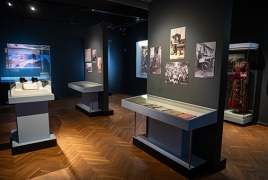
A temporary exhibition titled Camp Oddo, Marseille: A Story of Genocide Survivors has opened at the History Museum of Armenia, showcasing unique items from France — including passports, photographs, documents, and other memorabilia — that tell the story of Armenian refugees who escaped the Genocide.
The materials about Armenian refugees who found shelter in the Camp Oddo in Marseille were provided by the French ARAM Association for Research and Armenian Memory Archives. Dedicated to the 110th anniversary of the Armenian Genocide, the exhibition officially opened on April 25, reports Armenpress.
David Poghosyan, Director of the History Museum of Armenia, noted that, for the first time, over fifty documentary materials from Marseille have been brought to Armenia and combined with valuable artifacts from the museum’s collection, such as clothing and jewelry. The centerpiece of the exhibition is Nansen’s passport, recently donated to the museum by the ARAM Association.
“The exhibition offers an opportunity to explore important layers of historical events, particularly the stories of survivors. We believe this collaboration introduces a new format, linking the central museum with diaspora heritage centers, thus creating new ways to perceive various facets of our cultural heritage and identity,” said Poghosyan, expressing gratitude to the Ministry of Education, Science, Culture and Sports of Armenia and the French Embassy in Armenia.
He also emphasized that the exhibition serves as a special tribute of gratitude to France, which embraced many survivors of the Armenian Genocide and continues to support them to this day.
Deputy Minister of Education, Science, Culture and Sports, Alfred Kocharyan, praised the cooperation with Armenian communities, calling it an important and meaningful strategic move. He specifically highlighted that the "Nansen passport" donated to the History Museum will become part of its permanent exhibition.
The exhibition will run until May 25.
The French Camp Oddo, established in 1922 and operational until 1927, hosted over five thousand Armenian refugees. Its records have been digitized, enabling future generations to trace their ancestors’ histories. According to the data, most refugees came from Sivas. The camp’s director was Armenian and fluent in French. A school for 400 Armenian students operated there, alongside various compatriotic and church associations, one of which was founded by survivor Grigoris Balakian.

